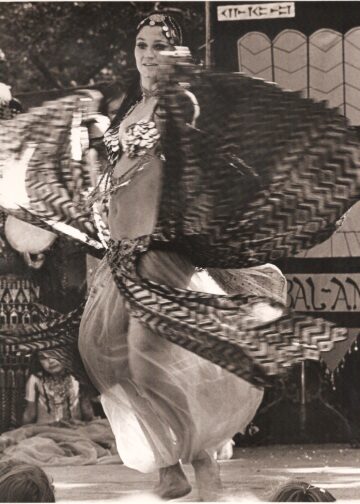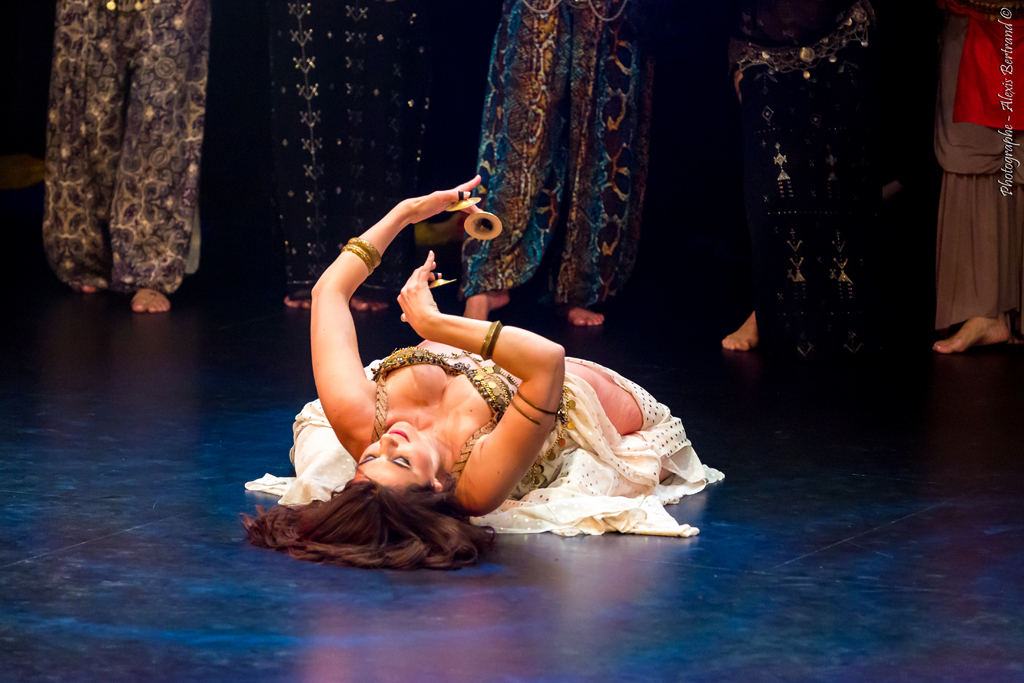Veil Work as Taught by Jamila
For the dancers from the Middle East that Jamila studied or for those with whom she worked, veil work was not a featured element. But in the U.S., as multi-part routines became more popular, so did veil work. One entire taqsim was typically devoted to the unwrapping of and dancing with the veil.
For Jamila’s students who were hired to perform in restaurants and nightclubs, Jamila gave them instruction on what she learned through her contemporaries and through her own experimentation. The provided veil work is a basic formula to be adapted to the music and adjusted based on a dancer’s experience.
This instruction was included in the original manual and includes the original Veil diagrams drawn by Ghanima Gaditana.
Needed: Three yards of chiffon (or similar soft fabric).
1) To wear the veil, start with the veil in front of you. Hold the selvage edge with your right hand and the left corner with your left hand.
2) Gather the veil in pleats with your right hand, pulling up the bottom corner until it is drawn up halfway.
3) Drop your left hand.
4) Grab the gathered veil about one foot down, making a pouf.
5) Tuck the pouf at your right hip. Find the selvage edge and bring it behind you to the left and around to the front.

6) Bring the veil under your left arm or
7) Bring the veil over your left arm and tuck it into the right halter strap.
8) To remove the veil, pull it out of the halter. Holding your left hand (palm up), place the top corner of the veil between your third and fourth fingers.
9) Bring your hand behind your head (behind your right eye) for CCW Pivot.
10) Continue bringing the veil around the right side, in front of you. . .

11) . . .and around your left side so you are wrapped in the veil. Undulate. Arabic 1 turning CW in place.
12) Bring the veil forward around to your left. . .
13) . . . around in front, past the right side behind you.
14) Place the veil over your left arm.
15) Pull the pouf from your right hip and take the whole veil in your hands between your thumb and fingers behind the pelvic area. Pull the veil taut, making a girdle for Circle Step.

16) Drop the veil with your right hand.
17) Bring the veil around in front.
18) Hold the veil on the selvage edge, hands about three feet apart. Arms in 5th with hands touching to frame your face, keeping your elbows inside the veil.
19) Bring the veil in front. Lower your left hand and raise your right hand, creating a space between your right arm and the veil.
20) Walk forward through space, trailing the veil behind you.

21) Left hand in 5th and right hand in 2nd, spin CCW and then CW. Spin CCW as you move your right arm up and down for butterfly effect.
22) Bring your right hand to your left hand overhead, closing the veil around you, both ends being held in one hand, while the other hand holds the veil taut. Be aware of which fingers are holding the front and the back of the veil.
23) Drop the back of the veil, which brings it in front of you. Shoulder shimmy walking forward and back into the veil.
24) Pull the veil tightly over your chest, holding snugly behind your back with one hand.
25) Let go of the veil to bring it in front. Holding the selvage with your hands about one foot apart, fold the selvage over two inches and bring over your nose and behind your head. Catch and hold snugly with one hand for a nose frame, making sure the arm and elbow are inside the veil.

26) Allow the veil to fall over your forearms.
27) Bring your hands up, around and down under the veil to wrap it around your wrists. Bring your arms overhead for Maya.
28) Bring the veil to the pelvic area for undulations.
29) Place the veil over your neck, making sure it falls evenly to the floor behind your shoulders.
30) Find the selvage edges behind you and hold the veil up, forming wings. Spin.

31) Find the selvage edge, allowing the veil to fall in front.
32) Walk between the veil and your right arm, trailing the veil behind you.
33) Tuck one selvage edge into the right side of your belt and take both corners of the end of the veil.
34) Hold the corners up behind your head to frame your body as you spin CCW and then CW.
35) Keep your arms overhead and release your left hand.

36) Take the corner of the veil being held by the right hand into the left hand.
37) Slide right hand down inside of the selvage edge of the veil.
38) Repeat, again replacing the right hand with the left and sliding the right hand down, pulling the veil out of your belt.
39) When through with the veil, bring it behind your head and simply drop it unobtrusively at the edge of the stage. Retrieve the veil when you exit the stage.



Floor Routine as taught by Jamila from the original Danse Orientale
Going to Floor
Spin and go to one knee. Arms in 2nd, spin smoothly in one spot. When ready to descend, face front and place one knee on the floor and then the other knee; with knees together, sit back on your calves with your arms up.

Crawl Forward & Sit
Arms in 5th, rise on your knees [1-2], move forward on the right knee and close the left knee [3-4], slowly sit on your feet [5-8]. Repeat moving forward with your left knee first. [1-8].
Crawl Back & Sit
Repeat Crawl Forward & Sit, but traveling backwards.
Turn on Knees & Sit
Rise to your knees [1-2], turn on the right knee 1⁄4 CW to right [3-4], arms in 2nd [1-4]. Sit on your feet, arms in 5th [5-8]. Repeat with your left knee turning CCW.
Sit on Hip & Turn
Sit to the right with your knees and feet to the left so the right hip takes your weight on the floor [1-4]; keeping your knees and ankles together, straighten your knees slightly. With feet “nailed” to the current spot, bring your knees CCW up, over, and down [5-8]. Turn CCW 1⁄2 turn, ending with your weight on your left hip with your knees and feet to your right [1-4]. Shift your body to the right, so your weight is on your knees again, and sit on your feet [5-8]. Repeat. Arms improvise.
Hip Circle
Rising slightly off the feet, exterior hip circle CW eighthtime downbeat left [1-8]. Reverse. Arms improvise.

Half Circle
Rising slightly off your feet, alternating 1/2 exterior hip circles front dominant quartertime downbeat left. Repeat. Arms improvise.
Basic Taqsim
Arms in 5th, rise slightly off your feet. Basic Taqsim alternating slow-slow- quick-quick-quick (R L RLR, L R LRL) [1,2,3&4, 5,6,7&8]. Repeat.
Shimmy Up and Down
Alternating singles doubletime downbeat right as you rise up on your knees [1-4] and sit on your feet [5-8]. Repeat. Rise slightly off your feet, alternating singles doubletime downbeat right [1-4], alternating singles halftime downbeat R [5-7], pause [8]. Reverse. Arms improvise within 2nd position.
Maya
Maya quartertime downbeat right. Repeat.
Shoulder Shimmy
Sitting on your feet, arms in relaxed 2nd, alternating shoulder presses forward doubletime downbeat right [1-4], alternating shoulder presses halftime downbeat right [5-7], pause [8]. Reverse.
Turkish Drop Position
Arms forward at shoulder level. Spread your feet apart and sit between them so the tailbone is on the floor [1-2]. Gradually press back to the floor, rounding back and shoulder ending lying on back with feet beside hips [3-8]. Extend arms to sides in 2nd and along floor to 5th overhead.
Body Circle
Hips, knees and feet stay still. Move slowly keeping body as close to floor as possible throughout. Keep arms extended overhead, brushing the floor. From Turkish Drop, pull upper body to left. Roll shoulders forward and continue circling body CW in a horizontal circle. Keeping your nose close to the floor and arms extended along the floor, circle the upper body forward and to the right. Roll shoulders back so flat with floor again and continue circling body CW to center back. Repeat.
Arch Up
Press hips forward and up by tensing your thigh muscles as if trying to straighten your knees. Upper body and head remain relaxed and back until hips are over knees and your center of gravity is well forward [1-2]. Bring your body forward to upright [3-4].
Rising from Floor
Crawl and pull: place the right foot forward [1-4], pull your left knee closed behind [5-8]; repeat. Crawl and Up: place your right foot forward with your full weight [1-4] and rise to standing position, closing the left foot behind [5-8]. Arms improvise at or above shoulder level.

Turkish Drop
When Jamila observed Tabora Najim, a Turkish dancer, spinning and quickly dropping to the floor into a backbend with her legs tucked underneath her, she named it the Turkish Drop. She taught it to her students, and it quickly became popular throughout the belly dance community; many dancers performed it in their nightclub sets in the 1960s and 1970s. However, the Turkish Drop is incredibly dangerous, leaving even well-trained and responsible dancers vulnerable to serious injury.
For students interested in performing the Turkish Drop, proceed with caution. Find a qualified teacher who can test your abilities to know how to help you strengthen, prepare, and train your body to execute the move safely.
Note that there is a difference between the actual drop itself and then the Turkish Drop Position once you are on the floor. Dancers can be in this floor position safely with training, and there are safe ways of moving in and out of this position that don’t require a drop.


The content from this post is excerpted from The New Danse Orientale: Salimpour Belly Dance Instruction, published by Suhaila International in 2013 with updates and additional content added in 2023. The New Danse Orientale is a study guide and resource for belly dancers when learning Salimpour Vocabulary steps and step families.
If you would like to make a citation for this article, we suggest the following format: Salimpour, J. & Salimpour, S. (2023). Veil Work, Floor Work, Tuskish Drop. Retrieved –insert retrieval date–, from https://suhaila.com/veil-work-floor-work-turkish-drop


